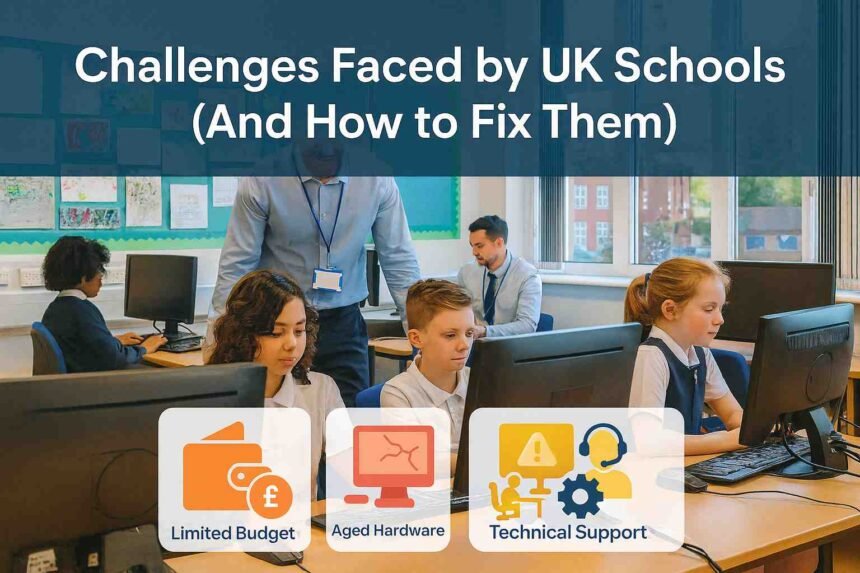Schools in the United Kingdom are becoming more reliant on technology to provide quality education. From interactive whiteboards to online learning platforms, digital tools have taken the central stage in teaching and learning. Nevertheless, this increasing dependency is accompanied by serious challenges that can interfere with the daily operations and affect student performance. Most schools have low budgets, old equipment, and a lack of technical skills, and these issues frustrated everyone, including teachers, administrators, and students. The solutions to these problems must be practical, balancing cost-efficiency with long-term sustainability. Learning about schools’ most common IT challenges is the first step towards a more resilient technology infrastructure.
Let’s look at the top 5 IT challenges in schools.
-
Budget constraints and limited resources
Today, one of the most important IT problems in UK schools is the financial pressure. Most institutions have difficulty deciding where to invest their limited resources, and technology is usually at the bottom of the list. This forms a vicious cycle of old systems failing often, requiring emergency repairs, which drain even more resources.
So, follow this innovative budget management:
- Multi-year technology plans that focus on the key upgrades and distribute expenses
- Local business alliances for equipment donation
- Leasing agreements that make new technology accessible
- Routine maintenance programmes avoid expensive emergency maintenance
These strategies help schools make the most of small resources and develop long-term infrastructure.
-
Outdated IT infrastructure and equipment
Ageing hardware and software cause headaches for every staff member and student. Slow computers waste valuable learning time, and incompatible systems make accessing the latest educational tools difficult. So, get a practical solution for this challenge.
Practical solutions are:
- Phased replacement programmes, which update equipment in 3-5 years.
- Refurbished devices from certified sellers with warranty protection
- Get cloud-based platforms, lowering the reliance on high-performance local systems
- Asset management systems to track equipment age and plan replacements
Prioritise the most important areas first, i.e., those devices used during examinations or core teaching, which helps schools maximise impact. Consistent and strategic investment can thus solve these education IT issues.
-
Cybersecurity threats and data protection
Another one of the biggest and most common school technology issues is cybersecurity threats. Schools store immensely sensitive data about students, staff, and families, which exposes them to cybercriminals who find it easy to exploit the weaknesses in old security systems. As a result, data breaches have several legal repercussions, reputational losses, and loss of trust in the community.
Cybersecurity issues can be practically solved with these measures:
- Good security practice is built on strong password policies.
- Employees and students should be trained to know about phishing and suspicious activity.
- Frequent software updates fill security loopholes before they are exploited
- Multi-factor authentication provides security to high-risk systems
- Backup processes ensure the recovery of data anytime
Getting school IT support services from trusted professionals is the smartest move.
-
Insufficient technical support and expertise
Most teachers are trained to educate children, and not troubleshoot technology. As a result, when things go wrong, the lessons are interrupted, and a lot of time is wasted. Most schools rely on a single IT coordinator or untrained volunteers. This reactive approach is associated with higher downtime and frustration.
IT support for schools in the UK has developed, and many providers provide flexible packages to schools depending on their available budgets. Remote support addresses these numerous problems in real time without necessarily requiring an on-site visit. External support teams come in with expert knowledge on IT issues in the education sector that the internal staff might never see.
-
Network connectivity and bandwidth problems
Slow internet speeds frustrate teachers trying to stream educational videos or access online resources. As the number of devices connecting concurrently increases, the old network infrastructure fails. Some buildings have dead zones, making wireless inaccessible, leading to disparity in learning opportunities on campus.
It is where network monitoring identifies network bottlenecks and coverage gaps that should be addressed. Additionally, upgrading to entire-grade wireless access points improves reliability and coverage. Content filtering and bandwidth control software give more preference to educational traffic over recreational use. Scheduled updates at off-peak hours to avoid using bandwidth during lesson time. These advancements change the way technology works during the school day.
Conclusion
IT challenges in schools will not go away in a flash, but there are specific interventions that make a tangible impact. The schools that design effective technology plans, take external help, and invest consistently positively always see measurable advantages. It is not necessary to hire costly overhauls, but to think creatively to meet budget limitations. Training in-house staff builds internal capability, while an external partnership brings a considerable advantage of specialist knowledge.
Handling school IT support challenges systematically provides an environment where technology can facilitate learning and not hinder it. With the right approach, even schools with a small budget can develop a strong technology infrastructure that serves their operations well. Partnering with Cygnet IT Services can help schools access expert guidance, reliable support, and sustainable technology solutions tailored to their specific needs.







